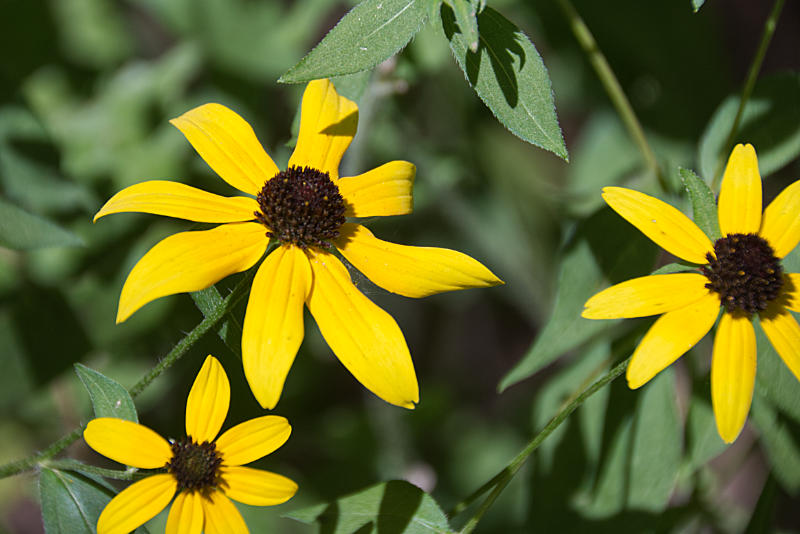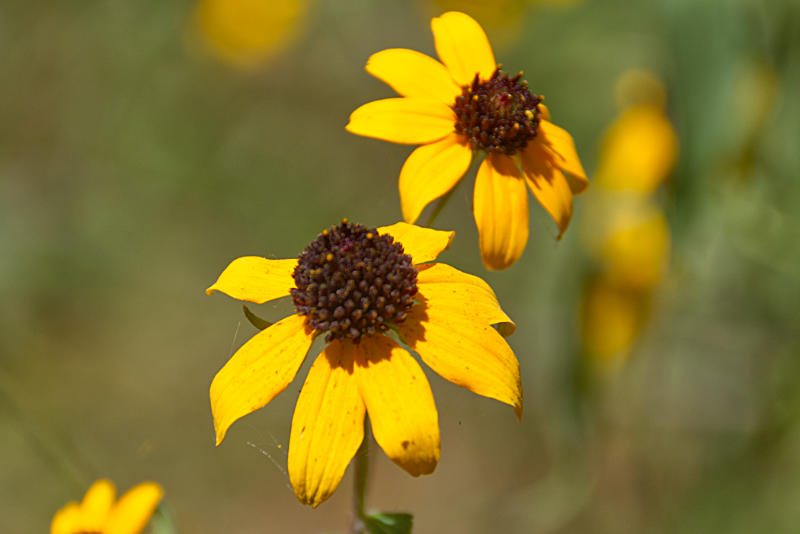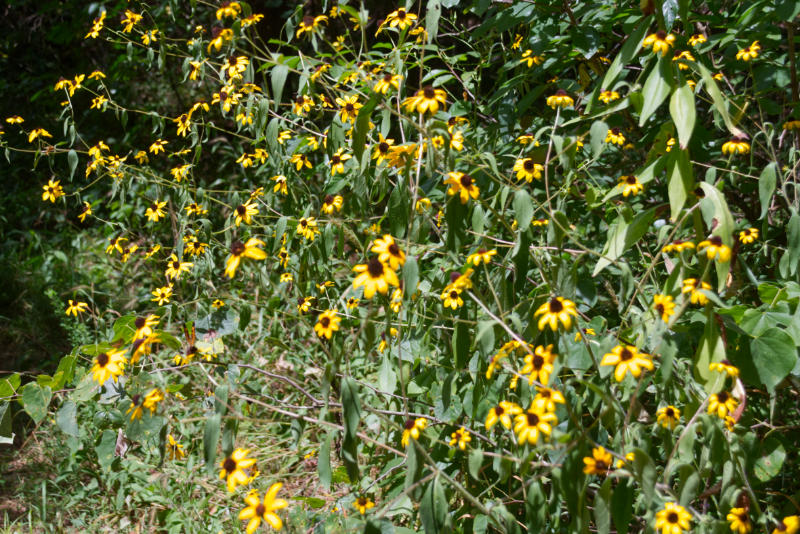
Welcome to the sunny world of Brown-eyed Susan, the cheerful little flower that never fails to brighten up any garden! This hardy wildflower is not only beautiful but also has a long history of use in traditional medicine. In this article, we’ll explore the many uses of this beloved wildflower. So, whether you’re a gardener, or simply looking for a little sunshine, keep reading!
The Brown-Eyed Susan (Rudbeckia triloba) is a flowering perennial plant native to North America. It is a member of the aster family, which also includes sunflowers and is one of the largest plant families. It is known for its bright yellow or orange petals and dark brown central disks. The flowers typically bloom in late summer and continue to bloom into fall. The plant can grow up to 4 feet tall and has a bushy, upright appearance. The leaves are lance-shaped and are arranged alternately on the stem. The plant is a popular choice for gardens and wildflower meadows. It is easy to grow, drought-tolerant, and attractive to pollinators. In addition to its ornamental value, the plant also has several edible and medicinal uses. The petals, leaves, and seeds can be eaten, and the plant has been used traditionally for various ailments, including fever and sore throat. Modern research has shown that the plant may have anti-inflammatory properties and may help treat certain skin conditions.
Native Range and Habitat
The Brown-Eyed Susan is native to the central and eastern United States. It is commonly found in the Great Plains region, from Texas to South Dakota, and from Kentucky to Minnesota. It is also found in the Appalachian Mountains and the Ozark Mountains, as well as in the Northeastern and Midwestern states. It is less common in the West.
In terms of habitat, the Brown-Eyed Susan is a versatile plant that can be found in a wide variety of different environments. It is commonly found in meadows, prairies, and along roadsides, as well as in open woods, fields, and gardens. It can be found in a variety of soil types, including sandy and clay soils, but it prefers well-drained soil and full sun. However, it can tolerate partial shade. The plant is also drought-tolerant and can be found in dry, rocky areas, and adapts well to a wide range of pH. This species typically blooms in late summer to early fall, and it can reach up to 4 feet tall.
It is important to note that the common name “Brown-Eyed Susan” is also used for other plants, such as Rudbeckia hirta, and it is important to distinguish the species by their scientific name to understand their specific range and habitat.
Physical Characteristics of Brown-eyed Susan
The flowers of Black-eyed Susan are typically 2-3 inches in diameter, with a central brown or black disk that is surrounded by yellow or golden-brown petals. The petals are slightly ruffled and have a slightly reflexed shape, giving the flower a “daisy-like” appearance. The flowers are typically arranged in clusters at the top of the stem.
The leaves of the Brown-Eyed Susan are lance-shaped and are arranged alternately on the stem. They are typically 2-5 inches long and 0.5-1.5 inches wide. The leaves are a bright green color and have a slightly hairy texture. They are also slightly toothed or scalloped along the edges. The leaves are attached to the stem by short petioles. The stem of the plant can grow up to 4 feet tall and have a hairy or downy texture and can be green or reddish in color.
It is important to note that the size and shape of the flowers and leaves may vary depending on the growing conditions and the specific cultivar. Some cultivated varieties may have larger or smaller flowers and leaves, or they may have slightly different colors or patterns.
Brown-eyed Susan typically blooms in late summer and continues to bloom into the fall, with peak blooming typically occurring in August and September. The blooming period can last anywhere from 6 to 8 weeks.
The timing can vary depending on the location and climate. In warmer regions, the plant may begin to bloom as early as July, while in cooler regions, the blooming period may not begin until September. The duration of the blooming period may also be affected by the amount of sunlight and water the plant receives, as well as the specific cultivar. Some cultivated varieties may have longer or shorter blooming periods.
The blooming period of the Brown-Eyed Susan is not only limited to one specific time of the year. Some cultivars can produce blooms over an extended period from summer to fall. The plant also can self-sow, which means that it can produce new flowers even after the initial blooming period is over.

Culinary and Medicinal Uses for Brown-eyed Susan
Culinary Uses
The Brown-Eyed Susan has a long history of use as a food source. The leaves, petals, and seeds of the plant are all edible and have been used in various traditional dishes and medicinal remedies.
The leaves can be eaten raw or cooked, and they have a slightly bitter taste. They can be used in salads, soups, or cooked as a green. They are also high in vitamins and minerals, including vitamin C and iron. It is important to note that the leaves should be harvested before the plant flowers, as they can become more bitter once the plant begins to bloom.
The petals of the flower can also be eaten and have a slightly sweet and tangy taste. They can be used as a garnish, in salads, or as a colorful addition to sandwiches. They are also high in antioxidants.
The seeds of the plant are also edible and are a good source of protein and essential oils. They can be ground into flour or meal and used in baking or as a thickener for soups and stews.
It should be noted that while all parts of the plant are edible, they should be consumed in moderation. Some people may be sensitive to the compounds in the plant. It is also important to make sure that the plant is not treated with any pesticides or herbicides before consumption. Another caution is to avoid gathering them from roadsides if you plan to consume any part of the plant. They may have absorbed toxins from the exhausts of automobiles that have entered the soil.
Medicinal Uses
The Brown-Eyed Susan has a long history of use in traditional medicine. The plant has been used to treat various ailments, including respiratory problems, fever, and sore throat.
The plant is known to have anti-inflammatory properties, which makes it useful in treating respiratory issues such as bronchitis, asthma, and chest congestion. The plant is also high in antioxidants, which may help to protect the body against free radicals and inflammation.
The plant has been traditionally used to reduce fever and treat sore throat. The leaves and flowers contain compounds that are thought to have a soothing effect on the throat, making them useful in treating sore throat and other respiratory issues.
The plant is also used to treat skin conditions such as eczema and psoriasis, as it has anti-inflammatory properties that can help to reduce redness and itching.
There is limited modern research to support its traditional uses and to understand its potential health benefits. Although some studies have been conducted to investigate the medicinal properties of the plant.
One study published in the Journal of Ethnopharmacology in 2011, investigated the anti-inflammatory properties of the plant and found that the plant contains compounds that have anti-inflammatory effects. The study suggests that the plant may be useful in treating inflammatory conditions such as asthma and bronchitis.
Another study published in the Journal of Natural Products in 2013, found that the plant contains flavonoids which have antioxidant properties and may be useful in protecting the body against free radicals and inflammation.
A study published in the Journal of Ethnopharmacology in 2015, investigated the potential use of the plant in treating skin conditions such as eczema and psoriasis. The study found that the plant has anti-inflammatory properties and may be useful in reducing redness and itching associated with these conditions.
It is important to note that while these studies suggest potential health benefits, more research is needed to fully understand the medicinal properties of the plant and to confirm its traditional uses. It’s also important to note that the plant should not be consumed in large amounts as it can cause gastric discomfort, and it is not recommended for pregnant women or people with liver or kidney disease. It is always advisable to consult with a healthcare professional before using any plant for medicinal purposes.

Cultivation and Care of Brown-eyed Susan
Soil and light requirements
The Brown-Eyed Susan is hardy and adaptable and can grow in a variety of soil types and light conditions.
It prefers well-drained soils that are rich in organic matter. It can tolerate a wide range of soil pH levels, from acidic to neutral to slightly alkaline. It can also tolerate soils that are sandy or contain clay. The plant can grow in both dry and wet soils as long as it has good drainage.
In terms of light, the Brown-Eyed Susan prefers full sun, but it can tolerate partial shade. The plant will produce the most flowers and have the most robust growth when grown in full sun. It will still produce some flowers in shaded areas, but the overall growth will be less vigorous and the number of flowers will be lower.
The plant is drought-tolerant, which means that it can survive in dry conditions but it will perform better when provided with adequate moisture. It should be watered during prolonged dry spells or droughts to ensure optimal growth and flowering.
The specific soil and light requirements may vary depending on the cultivar and location. It’s always advisable to check with a local nursery or consult with a local expert to ensure that the plant you choose will thrive in your specific growing conditions.
Propagation methods
Several different methods can be used to propagate Brown-Eyed Susan. These include:
- Seed sowing: The most common method of propagating Brown-Eyed Susan is by sowing seeds. Seeds can be collected from the flowers at the end of the growing season, or purchased from a seed supplier. They should be sown in a well-drained area and covered lightly with soil. They should be kept moist and warm until germination, which typically takes place within 10-14 days.
- Division: Another method of propagating the Brown-Eyed Susan is by dividing the clumps of established plants. This is best done in the spring or fall when the plant is dormant. The clumps should be dug up, and the individual plants should be separated and replanted in their new location.
- Root cuttings: Root cuttings can also be taken from established plants and used to propagate new plants. This method is best done in the fall or early spring when the plant is dormant. Cuttings should be taken from healthy roots and planted in a well-drained area.
- Stem cuttings: Stem cuttings can also be taken from healthy and mature plants and used to propagate new plants. The cuttings should be taken from non-flowering shoots in the late spring or early summer. They should be planted in a well-drained potting mix and kept moist until they have rooted.
It’s important to note that the success rate of these methods may vary depending on the specific growing conditions and the cultivar.
Pest and Disease Control
The Brown-Eyed Susan is generally a hardy and disease-resistant plant, but it can be susceptible to a few pests and diseases. Here are some common issues and ways to manage them if you want to grow them in your garden:
- Aphids: Aphids can be a problem for the Brown-Eyed Susan. They suck the sap from the leaves, causing them to turn yellow and become distorted. They can also leave a sticky residue on the leaves, which can attract ants and sooty mold. To manage aphids, you can use insecticidal soap or neem oil. You can also encourage natural predators such as ladybugs, lacewings, and parasitic wasps.
- Leaf miners: Leaf miners are tiny insects that tunnel through the leaves, leaving visible trails. They can cause the leaves to become distorted and discolored. To manage leaf miners, you can use insecticidal soap or neem oil. Also, removing and destroying the affected leaves can help to reduce the population.
- Powdery mildew: This is a fungal disease that can cause the leaves to turn yellow and become covered in a white powdery mold. To manage powdery mildew, you can use a fungicide specifically labeled for powdery mildew. Good air circulation, avoiding overcrowding of plants, and keeping foliage dry, can also help to prevent powdery mildew from developing.
- Rust: Rust is another fungal disease that can affect the Brown-Eyed Susan. It causes the leaves to turn yellow and develop rust-colored spots. To manage rust, you can use a fungicide specifically labeled for rust. Also, removing and destroying the affected leaves can help to prevent the spread of the disease.
Conclusion
In conclusion, the Brown-Eyed Susan is a hardy and adaptable perennial wildflower that is native to the central and eastern United States. It is known for its showy yellow or golden-brown flowers, which bloom in late summer to early fall. The plant is versatile and can be found in a variety of different environments, including meadows, prairies, and along roadsides. It can tolerate a wide range of soil types and light conditions and is drought-tolerant. It has a long history of use in traditional medicine, and modern research suggests it may have anti-inflammatory and antioxidant properties. However, more research is needed to fully understand its medicinal properties. It is also important to note that the plant should not be consumed in large amounts as it can cause gastric discomfort, and it is not recommended for pregnant women or people with liver or kidney issues. The plant can be propagated by seed sowing, division, and root or stem cutting, and it’s important to understand pest and disease management to keep the plant healthy and beautiful. The Brown-Eyed Susan is a versatile and beautiful wildflower that is a great addition to any garden or wildflower meadow.
For further info on the Brown-eyed Susan, you can read more about it here. You can read about other edible and medicinal plants on our blog.
FAQs:
Native Range and Habitat
Q: What is the native range and habitat of Brown-eyed Susan?
A: Brown-eyed Susan is native to North America and can be found growing in meadows, prairies, and along roadsides and stream banks.
Physical Characteristics of Brown-eyed Susan
Q: What are the physical characteristics of Brown-eyed Susan?
A: Brown-eyed Susan is a perennial plant that can grow up to 6 feet tall. It has yellow-orange flowers with dark brown centers that bloom in the summer and fall. The leaves are hairy and lance-shaped.
Culinary and Medicinal Uses for Brown-eyed Susan
Culinary Uses
Q: Can Brown-eyed Susan be used in cooking?
A: The Brown-Eyed Susan has a long history of use as a food source. The leaves, petals, and seeds of the plant are all edible and have been used in various traditional dishes and medicinal remedies.
Medicinal Uses
Q: What are the medicinal uses of Brown-eyed Susan?
A: Brown-eyed Susan has been used in traditional medicine to treat a variety of ailments such as colds, flu, and infections. It is also used to treat inflammation, menstrual cramps, and as a diuretic.
Cultivation and Care of Brown-eyed Susan
Soil and light requirements
Q: What are the soil and light requirements for Brown-eyed Susan?
A: Brown-eyed Susan prefers well-drained soil and full sun to partial shade. It can tolerate a range of soil types, from sandy to clay.
Propagation methods
Q: How can I propagate Brown-eyed Susan?
A: Brown-eyed Susan can be propagated by seed or by dividing the root clumps in the spring or fall.
Pest and Disease Control
Q: What pests and diseases affect Brown-eyed Susan?
A: Brown-eyed Susan is generally not prone to serious pest or disease problems. However, it can be affected by aphids, slugs, and powdery mildew. Regular watering and keeping the area around the plant clean can help prevent these issues.